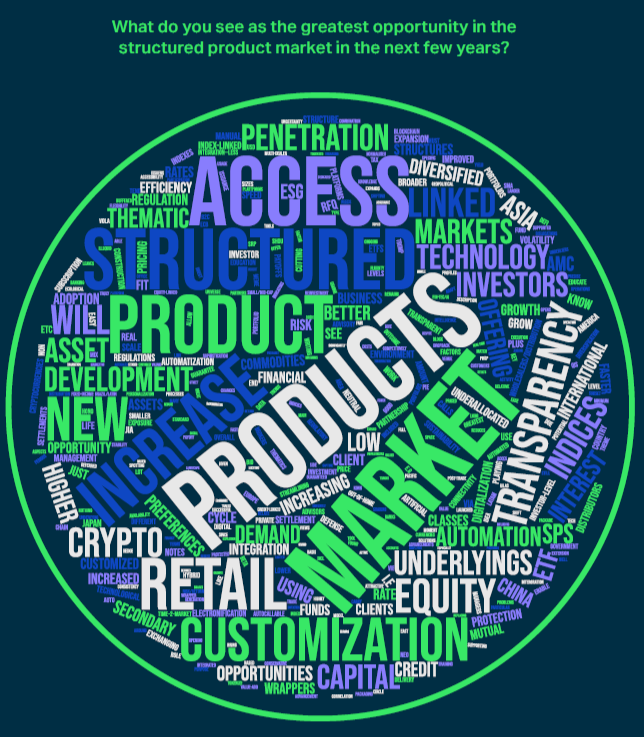The structured products industry has pushed through 2025 with resilience and optimism despite unprecedented global economic uncertainty. SRP and LPA’s, reveals an industry not only weathering volatility but often thriving because of it.
Chapter 3, Market Dynamics & Growth Opportunities, captures the industry’s regional hotspots, product growth trends and new opportunities.
FUNDAMENTAL
Fundamental economic factors and financial conditions will continue to dominate the structured products market over the coming years, according to SRP's survey participants.
When presented with a range of factors that might influence the market, whether negatively or positively, 75% of respondents chose 'economic and financial conditions', 57% confirmed 'investor demand/preferences' as a factor, 56% ticked the box for 'regulatory changes', 46% flagged 'technological advancements' and 34% opted for 'geopolitical factors'.
Respondents could tick more than one box and did so, suggesting that other than market conditions, no other single issue is expected to dominate.
We also asked respondents an open-ended question on the same theme, this time asking them to identify the greatest opportunity in the next few years.
It is no surprise to see economic fundamentals top of mind. This year has seen an unprecedented period of global economic uncertainty linked to US trade policy – which could come to be seen as the moment of a paradigm shift from an old, open era to a new, more closed era of protectionism.
Several respondents added comments to their survey responses that highlighted the opportunities created by market conditions. One Europe-based broker said: "If we have stability in a normalised rate environment... The potential for relative consistency of attractive product terms for lower risk investors is a better fit for structured products." Another middle European sell-side executive noted: "High vol (from geopolitical problems) and low rates (ECB) could increase demand for more conservative products (e.g. capital protection)."
"People acknowledge that they need to invest to generate returns in this bullish environment, but the concern is that the market is very volatile, so there is also the requirement for protection," added Schroders’ Moura.
Existing product structures can service that demand, however. This begs the question as to where growth opportunities lie in an industry already heavily developed in terms of underlying payoffs. Geography is one obvious answer.
GEOGRAPHY
Respondents to the survey were asked: 'Which market(s) will see the most growth/emerge as hotspots in the structured product market in the next 12 months (tick all that apply)'. Interestingly, no single region saw more than 50% of participants respond in the positive.
48% of respondents ticked Western Europe, 41% North America, and 40% Asia-Pacific, excluding China. The results could reflect a home or regional bias on the part of participants as much as assessments of global opportunities, but there is no doubt that Western Europe remains a primary nexus for retail structured products globally.
Société Générale’s e-business manager Elias Milan said that in Europe, regulations and client expectations will continue to accelerate the adoption of scalable and transparent digital platforms unlocking opportunities for innovation and competitive differentiation. “Top-tier” platforms, such as SocGen’s own SG Markets, “are built to respond to clients’ needs,” he said, “offering resilient automation capabilities that perform reliably even during volatile market conditions such as Liberation Day.”
Respondents also highlighted newer markets, including the Middle East, Asia and Latin American expansion, and noted that the US market remains significantly under-allocated to structured products.
For APAC, several specifically mentioned China, Hong Kong SAR, Taiwan and Japan as key markets. Here too global macro dynamics are having an impact on activity: "We are seeing more interest in Hong Kong," said one Singapore-based banker. "At the start of the year there was the DeepSeek surprise, and in April the US tariff volatility. Both, I think, contributed to investors shifting some of their capital to Hong Kong."
Société Générale’s Milan added that Asia “remains an ideal environment for digital client experience”.
Mid-way through 2025 it is not clear whether the pivot away from US equities towards markets in Asia and Europe will be short-lived. But regardless of the popularity of US assets, the US structured notes market itself is set for further development. "Asia is just so much larger because it's so much more ingrained in the investments market, but in the US there's a lot of potential for growth, particularly in the registered investment adviser segment," noted BBVA’s Garcia-Rubiales.
BBVA entered the structured products market in the US in 2017 and has been expanding its operations since then. "Last year, 2023-2024, we grew around 125%, and we're on target for at least 50% growth this year," she said, adding that BBVA expects to turn around US$5 billion in structured notes this year in the US.
"In the US, there's a lot of potential," confirmed Milan. "The growth is there, and issuers that are equipped to deliver modular, digital services are best positioned to capture meaningful market share and establish a competitive foothold.”
REGULATION
The survey asked what impact regulatory changes (such as greater transparency and investor protection) will have on the future of the structured products market. Almost 50% of participants responded in the positive, 35% gave a negative response, and 17% said there would be no significant impact.
Several respondents to our open-ended question highlighted regulatory opportunities including better regulatory environments, digital asset regulation, and regulation that opens markets and eases accessibility. One European asset manager, for example, noted the benefits likely to accrue from cryptocurrency adoption at government level, and associated regulatory improvements.
The regulatory question is, however, an apparently contradictory one, as will be explored further in the next section, where many also call it the industry's greatest challenge. This inconsistency is perhaps not surprising given how important the regulator's permissions and opinions can be to market development. Over 80% of survey respondents highlighted the regulatory landscape as a challenge that could be encountered when entering a new market, compared with the 48% who flagged investor demand and preferences, 40% the competitive landscape, and the 37% who cited economic and financial conditions.
TECH TOO
The industry's focus on technology as an innovation driver, and especially its role in enhancing operational efficiency, was covered in Section 2. But it is worth adding here that respondents also outlined technology's role as a creator of new market opportunities, particularly by opening access to end investors.
One middle-European exchange executive noted the potential, for example, in neo brokers (online brokers) creating access to new customer groups, including via out-of-home marketing.
Some highlighted increased digitisation to reduce minimums as a path to retail expansion, and several suggested tokenising structured products to increase exposure and create new market segments.
PRODUCT INNOVATION
When it comes to product development, 64% of survey respondents believed equity-linked products will see most growth in the future, 19% said thematic products will see most growth, while fewer than 10% saw major growth potential for credit or interest rate-linked products.
However, the open-ended responses revealed more diverse expectations, likely reflecting individual specialisms and product development projects. Here, credit-linked products were mentioned frequently, with one private banking respondent noting: "I see a lot of value in credit, as long as rates remain at these levels, carry trades are a big opportunity."
There were also multiple mentions of cryptocurrency products.
Thematic products emerged as an opportunity, with respondents citing potential for theme-based products, factor indices, and hybrid products on economic indicators.
ESG has been a major theme of the past decade, but appears to be declining in importance following recent policy shifts in the US and elsewhere. When asked how important respondents thought sustainability and DEI would be in the future, 30% responded 'less important', 28% expected 'no change', and 25% said it was 'quite important'. ESG did not emerge as a major topic in our series of interviews.
ESG was highlighted as an opportunity, whoever, among the open-ended responses. This is likely because it remains important for niche clients, so that when such products do launch, they can be of significant size.
Customisation emerged as a major product development theme, with multiple respondents highlighting opportunities for customised retail solutions, personalisation at scale, and customisation supported by higher levels of automation.
UniCredit’s Nikolaus Barth foresees a future market dynamic where more bespoke products will be sold. "Our approach is to focus more often on tailor-made solutions," he said. "We are offering people the opportunity to, 'tell us what you want as your underlying'. We then go off and do the calculations, and then the product is issued."
Within the last year his bank has issued more than 10,000 products using this tool. "This is not to say that we don't do larger products anymore, but we are seeing much more demand for smaller products," he said.
In terms of payoffs, respondents saw growth potential in yield-enhancing and capital-protection structures, buffered products, and autocallable/dropback notes.
Wrapper development was highlighted as a significant opportunity. Multiple respondents cited potential in ETFs / mutual funds, and AMCs. US respondents also saw potential in SMAs (see below) and registered index-linked annuities (RILAs).
CUSTOMER SEGMENTS
The open-ended responses expressed further ‘democratisation’ as a significant opportunity. Multiple respondents highlighted the potential for retail expansion, lower minimums to access more investors, and giving access to retail markets via digital platforms.
Abehassera at Lynceus Partners in London confirmed: "The greatest opportunity to me remains on the democratisation side: even though structured products have been retail-friendly since the early 1990s, there's still so much more to be done to 'democratise' them further. Thanks to tech, of course, but also to business and innovation-minded regulators, which will attract (and retain!) the next wave of fintech entrepreneurs."
In this vein, several respondents mentioned neo-brokers creating access to new customer groups, and private banking and retail distribution growth. Several respondents highlighted the potential for improved secondary market access.
The US RIA market was also a frequently-repeated opportunity, with an emphasis on creating a separately managed account offering to make the products accessible. Christopher Loudon at Raymond James said: "I think what's going to drive the broader market is the development of SMAs... you can kind of make the business a lot more efficient for the advisors and that's what will make it more scalable."
One market participant noted the opportunities presented by small and medium enterprises (SMEs), which, despite their financially sophisticated CFOs, usually leave their reserves earning relatively low yields on deposit.
EDUCATION
Education plays a prominent role in any widening-of-access story. Respondents identified education to enable broader access, and training, as key opportunities. Respondents also cited the potential for increased transparency and the standardisation of payoff descriptions. 1
"Structured products are not that complex, but they do take a bit of education and explanation so the end investor really understands what they are buying," explained BBVA's Garcia-Rubiales.
Respondents also highlighted opportunities for better partnerships between issuers and distribution partners to educate a broader subset of the market, and more product and investor sophistication in Asia.
[1] EUSIPA, Europe’s structured products industry membership body, provides standardised structured product payoff descriptions through its European Derivative Map.

